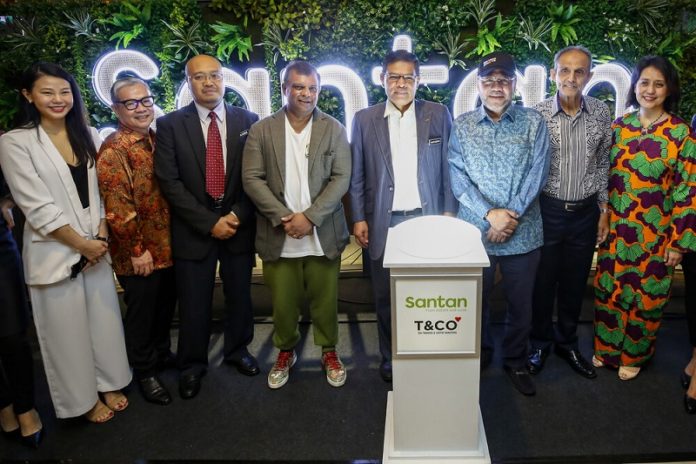Malaysia-based budget airline AirAsia has just opened a restaurant selling its airline food. The jokes are obvious, but CEO Tony Fernandes might actually have the last laugh on this – even if it flops.
Earlier this week, AirAsia launched the Santan restaurant and the TC & Co Café in the Mid Valley Megamall in Kuala Lumpur. Both take the name from the airline’s inflight food brands, and both sell essentially the same food served on the aircraft – nasi lemak, chicken rice, pineapple fish noodle, etc.
That said, the brand-named inflight dishes only account for about a third of Santan’s menu – Catherine Goh, the GM of the new restaurant/café business, told Reuters the rest of the menu was created by a product development team of “five chefs and culinary arts students” who spent nine months researching which ASEAN dishes would be a good fit and which recipe was the most “authentic”.
Customers can order food with an app that AirAsia says uses artificial intelligence and machine learning to recommend dishes based on time, past ordering patterns and demographics.
Goh explained at the launch event that AirAsia’s food is so popular with customers that the next logical step was to sell it to them in an actual restaurant – something that Tony Fernandes said in a LinkedIn post has been one of his lifelong dreams.
The Mid Valley restaurant is planned to be the first of many – Fernandes aims to open five Santan restaurants by the end of next year, and 100 franchisee-operated restaurants and cafes within the next three to five years, to include overseas.
The news – especially in western media – has been greeted with raised eyebrows and the usual quips about airline food being generally nasty, as well as the prospects of an airline getting into the restaurant business. But for my money, the idea isn’t as far-fetched as it sounds for a few reasons.
One: presumably AirAsia did due diligence with its market research to see if the venture was worth doing. (It’s also worth noting that technically they’re not the first airline to do this – the catering arm of Thai Airways currently operates four restaurants in airports in Thailand.)
Two: Food costs extra on AirAsia flights, so the sales pitch doesn’t involve customers being asked to pay for something that would normally be bundled with the airfare. They’re already used to paying for these food items on the plane, so paying for it in a restaurant or café isn’t that big a leap in terms of consumer mindset.
Three: Most importantly, AirAsia is one of the few airlines in the world structured to actually try something like this.
At our recent Frontiers of Work event last month, AirAsia’s former chief transformation officer Frederic Ducros talked about AirAsia’s digital transformation journey from being just another low-budget airline to a digital platform company that just happens to run an airline. It also has its own e-commerce site (OurShop), its own financial payments service (BigPay) and its own cargo and logistics service (Teleport).
The reason is simple: the airline business is highly competitive, low-margin and plagued by a culture of tradition and expensive legacy hardware – i.e. the airplanes. (Notably, AirAsia doesn’t even own any of its 250 planes – all are leased.) AirAsia’s strategy is to be an asset-light digital platform leveraging its massive trove of consumer and business data to branch out into all kinds of related services.
Earlier that week at Digital Transformation Asia in KL, AirAsia’s current chief transformation officer Azli Mohamed described the process as evolving from “AirAsia 1.0” (traditonal airline) to “AirAsia 3.0” – a digital superapp platform not unlike what companies like Grab and Go-Jek are doing. The platform model, combined with big data analytics, enables those companies to add new services quickly – and, more crucially, to drop those services just as quickly if they’re not gaining traction. Remember, in the digital world, risk is a virtue and failure is a learning experience, not a calamity.
AirAsia’s digital platform structure enables it to do things like create a brick-and-mortar restaurant for its inflight food brands. If it works, it works. If it doesn’t, lessoned learned – man down, move on. It’s no crazier than, say, Amazon buying Whole Foods and opening cashierless grocery stores.
Arguably the biggest obstacle Santan and TC & Co Café face is the stigma of airline food’s reputation as being either terrible or something you might tolerate at 30,000 feet when there’s no choice but you’d never order in a restaurant.
And, you know, to each their own. But personally, as someone who (1) travels a lot and (2) isn’t a foodie to the point of being snobbish, I think the bad reputation of airline food is … well, overbaked. Yes, there’s some awful food up there, but good airline food in economy class does exist – it depends on the airline.
Also, if the promo photos on social media are anything to go by, the restaurant version of Santan meals are freshly prepared rather than packaged and reheated. So if nothing else, AirAsia might be more in danger of its restaurant food making the airline version less appealing by comparison.
















